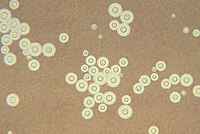
Photo from wikipedia
Nocardia species are low virulence bacteria found in nature. They can be an infectious agent, especially in patients with risk factors such as underlying immunosuppression, chronic lung disease, and malignancy.… Click to show full abstract
Nocardia species are low virulence bacteria found in nature. They can be an infectious agent, especially in patients with risk factors such as underlying immunosuppression, chronic lung disease, and malignancy. They can be easily overlooked because they are not seen frequently and has no pathognomonic symptoms. With this study, it was aimed to draw attention to the importance of microscopic examination of Gram-stained smears in the diagnosis of Nocardia infections in routine microbiology laboratories. Cases in which Nocardia spp. were detected in their clinical samples between November 2014-December 2015 in Hacettepe University Medical Faculty Hospital were included in the study. In the direct microscopic examination of Gram-stained smears of the samples arriving to the laboratory, the incubation periods of the cultures of the samples compatible with Nocardia spp. were extended. Then relevant colonies were identified by conventional microbiological methods and also by matrix-assisted laser desorption ionization-time of flight mass spectrometry (MALDI-TOF MS, bioMerieux, France) automated system. Species-level identification of Nocardia isolates was performed by 16S rRNA gene sequence analysis. To demonstrate the genetic relationship between Nocardia isolates, pulsed-field gel electrophoresis (PFGE) was performed. In vitro susceptibility of the isolates against amoxicillin-clavulanate (AMC), linezolid, moxifloxacin, trimethoprim-sulfamethoxazole (TMP-SXT), amikacin, imipenem, clarithromycin, cefepime, cefotaxime, ceftriaxone, and ciprofloxacin was determined using the gradient strip method (E-test). A total of 19 Nocardia spp. strains were isolated from eight patients. Four cases exhibited repeated growth of Nocardia spp. up to a period of nine months. The most frequently isolated species was N.cyriacigeorgica, which was identified in four cases. Other species isolated from patients were N.asteroides, N.transvalensis, N.farcinicia, and N.asiatica/arthritidis. When the results obtained with DNA sequence analysis and MALDI-TOF MS were compared, 16 (84.2%) of 19 isolates were correctly identified to the genus level and 9 (47.4%) to the species level with MALDI-TOF MS, while three (15.8%) isolates could not be identified, and seven (36.8%) isolates were misidentified. According to the PFGE results, it was determined that the strains isolated from the same patient were genetically identical. All isolates were susceptible to amikacin, cefepime, cefotaxime, ceftriaxone, imipenem, linezolid, and except one isolate to TMP-SXT. Among the study isolates, the most common resistance was against ciprofloxacin (62.5%), followed by clarithromycin (37.5%). N.cyriacigeorgica was determined as the most frequently detected and the most resistant species to antibiotics in the study population. Direct microscopic examination of clinical specimens is one of the most valuable methods for the identification of Nocardia-type bacteria, which is difficult to isolate in microbiology laboratories. With this study, the importance of examining Gram-stained clinical samples was emphasized in the identification of Nocardia species, which can emerge with a wide variety of clinical forms and can be easily overlooked. In addition, antibiotic susceptibility profiles of the isolated bacteria were determinedto contribute to species-specific susceptibility profiles. Accurate identification of Nocardia species will contribute to clinical and epidemiological studies.
Journal Title: Mikrobiyoloji bulteni
Year Published: 2023
Link to full text (if available)
Share on Social Media: Sign Up to like & get
recommendations!